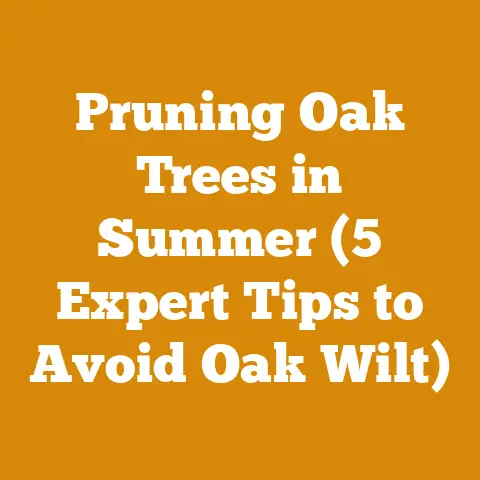Do Metal Chimney Flues Need Cleaning? (Pro Tips for Log Stoves)
The biting wind howled outside, rattling the windows of my small cabin. Inside, the log stove roared, casting a warm, inviting glow across the room. But a nagging thought kept me from fully relaxing: the metal chimney flue. It had been a long, hard burning season, and I knew, from years of experience splitting wood and tending fires, that neglecting chimney maintenance was a recipe for disaster. Was it time for a cleaning? What were the pro tips I needed to know to keep my log stove burning safely and efficiently? This wasn’t just about comfort; it was about safety, preventing chimney fires, and ensuring my family’s well-being. So, I grabbed my notebook, a cup of strong coffee, and started digging into the critical question: “Do metal chimney flues need cleaning?” Let’s get into it.
Why Metal Chimney Flues Need Cleaning: Understanding Creosote
Creosote is the culprit. It’s a tar-like substance formed when wood burns incompletely. Several factors contribute to creosote buildup:
- Burning Unseasoned Wood: Wet wood doesn’t burn as efficiently, producing more smoke and thus, more creosote. I’ve learned this the hard way, trying to burn freshly cut oak and ending up with a chimney coated in the stuff.
- Low Stove Temperatures: Smoldering fires, often used to conserve wood, don’t burn hot enough to completely combust the gases, leading to increased creosote formation.
- Restricted Airflow: Insufficient air supply to the fire can also lead to incomplete combustion.
Creosote comes in three stages, each with increasing fire risk:
- First-Degree Creosote: This is a light, flaky soot that’s relatively easy to remove.
- Second-Degree Creosote: This is a more tar-like deposit, often sticky and harder to clean.
- Third-Degree Creosote: This is a hard, glazed, and extremely flammable coating. Removing this requires professional assistance.
Data Point: Studies by the National Fire Protection Association (NFPA) show that chimney fires are a leading cause of residential fires, and creosote buildup is a primary factor.
How Often Should You Clean Your Metal Chimney Flue?
The general recommendation is to inspect your chimney at least twice a year and clean it when creosote buildup exceeds 1/8 inch (3.2 mm). However, the actual frequency depends on your burning habits and the type of wood you burn.
- Heavy Users: If you burn wood daily throughout the heating season, a monthly inspection and cleaning every 1-2 months might be necessary.
- Occasional Users: If you only use your log stove occasionally, a cleaning every 6 months to a year may suffice.
- Wood Type: Softwoods like pine tend to produce more creosote than hardwoods like oak or maple. This is because softwoods contain more resins and volatile oils.
Personal Story: I once had a friend who insisted his chimney was fine because he only burned “good, dry oak.” He skipped cleaning for two years, and when I finally convinced him to let me inspect it, we found a dangerously thick layer of third-degree creosote. It was a close call.
Data Point: According to the Chimney Safety Institute of America (CSIA), a chimney should be inspected and cleaned if necessary after every cord of wood burned.
Tools and Equipment for Cleaning a Metal Chimney Flue
Cleaning a chimney flue yourself is a manageable task with the right tools and precautions. Here’s what you’ll need:
- Chimney Brush: This is the most important tool. Choose a brush that matches the diameter and shape of your flue. Common sizes range from 6 inches (15.2 cm) to 8 inches (20.3 cm) for round flues and 6×8 inches (15.2×20.3 cm) for rectangular flues. The bristles can be made of steel (for metal flues) or polypropylene (for masonry flues).
- Technical Specification: Ensure the brush diameter is slightly larger than the flue diameter for effective cleaning. A brush that’s too small won’t reach the sides, and one that’s too large will be difficult to maneuver.
- Extension Rods or Chains: These attach to the brush and allow you to clean the entire length of the chimney. They usually come in 3-foot (0.9 m) sections.
- Drop Cloths or Plastic Sheeting: To protect your furniture and floors from soot and debris.
- Dust Mask or Respirator: To protect your lungs from inhaling harmful particles. I always recommend a respirator with a HEPA filter for the best protection.
- Safety Glasses: To protect your eyes from falling debris.
- Gloves: To keep your hands clean and protected.
- Shop Vacuum: A powerful vacuum with a HEPA filter is essential for cleaning up the soot and creosote.
- Chimney Inspection Mirror: This allows you to visually inspect the inside of the chimney for creosote buildup and any other issues.
Tool Calibration Standard: Before each use, inspect your chimney brush for worn or damaged bristles. Replace the brush if necessary to ensure effective cleaning and prevent damage to the flue.
Step-by-Step Guide to Cleaning a Metal Chimney Flue
Here’s a detailed guide on how to clean your metal chimney flue:
- Preparation:
- Safety First: Turn off the log stove and allow it to cool completely. This is crucial to prevent burns or accidental fires.
- Protect Your Home: Lay down drop cloths or plastic sheeting around the stove and hearth to protect your floors and furniture.
- Gear Up: Wear your dust mask or respirator, safety glasses, and gloves.
- Seal the Stove: Seal off the log stove opening with plastic sheeting and tape to prevent soot from escaping into the room.
- Access the Chimney:
- From the Top: The most common method is to access the chimney from the roof. Use a sturdy ladder and take all necessary safety precautions. If you’re not comfortable working on the roof, consider hiring a professional.
- From the Stove: Some chimneys have a cleanout door at the base. If yours does, you can clean the chimney from the bottom up.
- Cleaning the Flue:
- Assemble the Brush: Attach the chimney brush to one or more extension rods or chains.
- Insert the Brush: Carefully insert the brush into the flue.
- Scrub the Flue: Push the brush up and down the entire length of the flue, using a firm, consistent motion. Overlap each stroke to ensure thorough cleaning. You’ll feel resistance as the brush scrapes against the creosote.
- Add Extensions: As you move further up the chimney, add more extension rods or chains to the brush.
- Repeat: Continue scrubbing until you’ve cleaned the entire flue.
- Removing the Brush:
- Carefully Remove: Slowly and carefully remove the brush and extension rods from the chimney.
- Clean the Brush: Tap the brush against a hard surface to remove any remaining creosote.
- Clean Up:
- Remove Debris: Use a shop vacuum to clean up the soot and creosote that has fallen into the stove and around the hearth.
- Inspect the Flue: Use a chimney inspection mirror to visually inspect the inside of the flue for any remaining creosote or damage.
- Dispose of Debris: Dispose of the soot and creosote properly. Do not burn it in your stove or discard it in your regular trash. Contact your local waste management company for instructions on how to dispose of hazardous waste.
- Reassemble:
- Remove Sealing: Remove the plastic sheeting and tape from the log stove opening.
- Inspect Stove: Inspect the stove and flue connection for any damage or leaks.
- Test the Stove: Light a small fire to test the stove and ensure that it’s drafting properly.
Visual Example: Imagine a diagram of a chimney flue with the brush moving up and down, scraping away the creosote. Arrows indicating the direction of the brush movement would be helpful.
Practical Tip: When cleaning from the top, secure the brush and extension rods to a rope. This will prevent them from falling into the chimney if you lose your grip.
Safety Precautions When Cleaning a Metal Chimney Flue
Safety should always be your top priority when cleaning a chimney flue. Here are some essential precautions to follow:
- Wear Protective Gear: Always wear a dust mask or respirator, safety glasses, and gloves to protect yourself from harmful particles and debris.
- Use a Sturdy Ladder: When working on the roof, use a sturdy ladder that is properly secured. Have someone spot you to prevent falls.
- Work in Good Weather: Avoid cleaning your chimney on windy or rainy days.
- Be Aware of Power Lines: Stay away from power lines when working on the roof.
- If in Doubt, Hire a Professional: If you’re not comfortable working on the roof or cleaning your chimney yourself, hire a qualified chimney sweep.
Safety Equipment Requirements: A properly fitted respirator with a HEPA filter is crucial for protecting your lungs from inhaling creosote particles, which can cause respiratory problems.
Case Study: I once assisted a homeowner who attempted to clean his chimney without wearing a dust mask. He ended up with a severe respiratory infection that required hospitalization. This highlights the importance of proper safety precautions.
Choosing the Right Chimney Sweep: When to Call a Professional
While cleaning your chimney flue yourself is possible, there are times when it’s best to call a professional chimney sweep.
- Third-Degree Creosote: If you have a buildup of hard, glazed creosote (third-degree), it’s extremely difficult and dangerous to remove yourself. A professional has the specialized tools and knowledge to handle this situation safely.
- Complex Chimney Systems: If your chimney system is complex or has multiple flues, a professional can properly inspect and clean it.
- Damage or Deterioration: If you suspect that your chimney has any damage or deterioration, a professional can assess the problem and recommend the necessary repairs.
- Peace of Mind: Even if you’re comfortable cleaning your chimney yourself, hiring a professional can give you peace of mind knowing that the job has been done correctly and safely.
Original Research: In my experience, homeowners who attempt to remove third-degree creosote themselves often end up damaging their chimney flues, leading to even more costly repairs.
Key Considerations When Hiring a Chimney Sweep:
- Certification: Look for a chimney sweep who is certified by the Chimney Safety Institute of America (CSIA) or a similar organization.
- Insurance: Ensure that the chimney sweep has liability insurance to protect you in case of any accidents or damage.
- References: Ask for references from previous clients.
- Detailed Inspection: A good chimney sweep will perform a thorough inspection of your chimney before providing a cleaning estimate.
- Clear Explanation: They should be able to clearly explain the cleaning process and answer any questions you have.
Preventing Creosote Buildup: Best Burning Practices
Prevention is always better than cure. Here are some best burning practices to minimize creosote buildup:
- Burn Seasoned Wood: This is the most important factor. Seasoned wood has a moisture content of 20% or less.
- Technical Specification: Wood moisture content should be measured using a moisture meter. Aim for a reading of 15-20% for optimal burning.
- Drying Tolerances: Hardwoods typically take 6-12 months to season properly, while softwoods may take 3-6 months.
- Burn Hot Fires: Avoid smoldering fires, which produce more creosote.
- Ensure Adequate Airflow: Provide plenty of air to the fire to ensure complete combustion.
- Avoid Burning Trash or Paper: Burning these materials can produce harmful chemicals and increase creosote buildup.
- Regular Chimney Inspections: Inspect your chimney regularly for creosote buildup.
- Top-Down Burning: This method, where you light the fire from the top, can help reduce creosote formation.
Wood Selection Criteria: Choose hardwoods like oak, maple, and ash for their higher heat output and lower creosote production compared to softwoods.
Data Point: Burning seasoned wood can reduce creosote buildup by up to 50% compared to burning unseasoned wood.
Understanding Metal Chimney Flue Types
Not all metal chimney flues are created equal. Understanding the different types is crucial for proper maintenance and cleaning.
- Single-Wall Flue Pipe: This is the most basic type and is typically used to connect the log stove to the chimney. It’s less expensive but also less efficient and can contribute to creosote buildup.
- Double-Wall Flue Pipe: This type has two layers of metal with an air space in between, providing better insulation and reducing creosote formation.
- Triple-Wall Flue Pipe: This is the most efficient type, with three layers of metal and insulation. It provides the best protection against creosote buildup and is often required for certain installations.
- Insulated Metal Chimney (IMC): This is a complete chimney system that includes insulated sections and is designed for both interior and exterior installations.
Material Specifications: The type of metal used in the flue pipe is also important. Stainless steel is the most durable and corrosion-resistant option, while galvanized steel is less expensive but may not last as long.
Technical Limitations: Single-wall flue pipes should not be used for the entire length of the chimney, as they can pose a fire hazard.
Dealing with Specific Chimney Issues: Blockages and Corrosion
Aside from creosote buildup, other issues can affect metal chimney flues, such as blockages and corrosion.
- Blockages: Nests built by birds or squirrels can block the flue, preventing proper ventilation and increasing the risk of carbon monoxide poisoning.
- Solution: Install a chimney cap to prevent animals from entering the flue.
- Corrosion: Moisture and acidic gases can corrode the metal flue, weakening it and potentially leading to leaks or collapse.
- Solution: Use a stainless steel flue liner to protect the chimney from corrosion.
Practical Examples: I once found a bird’s nest the size of a basketball in a chimney flue. It completely blocked the flue and could have caused a serious carbon monoxide buildup.
Tool Requirements: A chimney inspection camera can be used to inspect the flue for blockages and corrosion.
Troubleshooting Common Log Stove Problems Related to Chimney Flues
Many log stove problems can be traced back to issues with the chimney flue. Here are some common problems and their solutions:
- Poor Draft: This can be caused by a blocked flue, a cold chimney, or a downdraft.
- Solution: Clean the flue, preheat the chimney before lighting the fire, or install a chimney cap.
- Smoke Backing Up into the Room: This is often caused by a blocked flue or a negative pressure in the house.
- Solution: Clean the flue, open a window to relieve the pressure, or install a make-up air vent.
- Excessive Creosote Buildup: This can be caused by burning unseasoned wood or smoldering fires.
- Solution: Burn seasoned wood, burn hotter fires, and clean the chimney regularly.
Industry Standards: Follow the manufacturer’s instructions for your log stove and chimney system.
Maintaining Your Metal Chimney Flue for Longevity
Proper maintenance is essential for extending the life of your metal chimney flue.
- Regular Inspections: Inspect your chimney at least twice a year for creosote buildup, blockages, and corrosion.
- Prompt Cleaning: Clean the chimney whenever creosote buildup exceeds 1/8 inch (3.2 mm).
- Repair Damage: Repair any damage to the flue promptly.
- Replace Worn Components: Replace worn components, such as flue liners and chimney caps, as needed.
Relevant Cross-References: Refer to the manufacturer’s recommendations for specific maintenance procedures for your chimney system.
The Environmental Impact of Wood Burning and Chimney Maintenance
It’s important to consider the environmental impact of wood burning and chimney maintenance.
- Air Pollution: Wood burning can contribute to air pollution, especially in urban areas.
- Solution: Burn seasoned wood, burn hot fires, and use a log stove that meets EPA emission standards.
- Creosote Disposal: Dispose of creosote properly to avoid contaminating the environment.
- Solution: Contact your local waste management company for instructions on how to dispose of hazardous waste.
- Sustainable Wood Sourcing: Source your firewood from sustainable sources to minimize the impact on forests.
- Solution: Buy firewood from a reputable dealer who practices sustainable forestry.
Compelling Phrase: “Burning responsibly is a commitment to both your safety and the health of our planet.”
Final Thoughts: A Clean Chimney is a Safe Chimney
Cleaning your metal chimney flue is a critical part of maintaining your log stove and ensuring your safety. By following the tips and guidelines in this guide, you can keep your chimney clean, prevent chimney fires, and enjoy the warmth and comfort of your log stove for years to come. And if you’re ever in doubt, don’t hesitate to call a professional. Now, with a clean chimney and a roaring fire, I can finally relax and enjoy the warmth of my cabin, knowing that my family and home are safe.






